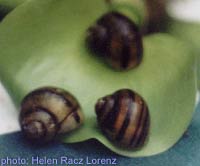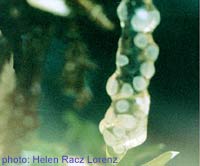|
Asolene (Asolene) pulchella
(Anton, 1839)
|
|
|
 Asolene (Asolene) pulchella snails. (picture not licenced under creative commons) |
Shell: The relative robust shell
of Asolene pulchella has a pointed top and the aperture (shell opening)
is oval in shape, in which the corneous operculum can be retracted. The sutures
are relatively flat and the umbilicus is of medium size.
The shell surface is smooth and has a yellow base colour with sharp, dark brown
spiral stripes on it. These dark band are mainly located at the underside of
the shell (near the umbilicus), giving the shell a dark apperance when seen
from the underside and a light colour from above.
Operculum: The corneous, medium thick operculum is concentric in construction
with the nucleus located near the center of the shell (towards the columella).
Body: ?
Eggs: The eggs are deposited below the water surface on objects or vegetation and are embedded in a gelatinous mass.
 Asolene (Asolene) pulchella eggs. Note that these eggs are taken out of the water. (picture not licenced under creative commons) |
Personal experiences with Asolene puelcha by Helen Racz Lorenz (http://moluscos.net/comer/hrl/):
Asolene puelcha spawns under the water, wrapping the eggs in a sticky
gelatine parcel, which keep them united and protected until the birth. By this
way, they keep themselves attached to the aquatic plants, for a period of approx.
20 days.
The development of the sprawning frequently fails when the environment conditions
are not in perfect balance, as they are weak to some aquatic parasites that
eat the small embryo before birth. These parasites are red earthworms of about
4 to 5 mm, extremely thin (like a hair). They perforate the gelatine mass, reaching
the eggs easily. One can find even up to 20 earthworms in a small egg mass.Once
they are born, the hatchlings are vulnerable to many natural enemies, like crustacea,
mosquito larvae and dragon-flies, both very are voracious predators. For this
reason while growing in captivity this species must be protected by covering
their habitat (I mean the place where they have been placed for growing- in
my experience a fish-globe) with a tulle cloth, to avoid these "annoying
lodgers".
The basic food is the lettuce, but they also like the green pulp of the water-melon,
(with minimum or nothing of saccharose), they do not like the red part of this
fruit. It is essential for their normal growth and the hardness of their shell
to add calciumcarbonate to their diet. We provide this by adding sea shells
(with no enamel) in the water.
Behaviour:
Habitat:
Distribution: Uruguay and Argentina.
Similar to: Asolene spixi.
|
Except where otherwise noted, this page is licensed under a Creative Commons Attribution-NonCommercial-ShareAlike 2.5 License . http://www.applesnail.net |
|